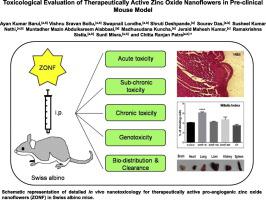NanoImpact ( IF 4.9 ) Pub Date : 2023-08-11 , DOI: 10.1016/j.impact.2023.100479 Ayan Kumar Barui 1 , Vishnu Sravan Bollu 1 , Swapnali Londhe 1 , Shruti S Deshpande 1 , Sourav Das 1 , Susheel Kumar Nethi 1 , Muntadher Mazin Abdulkareem Alabbasi 2 , Madhusudana Kuncha 2 , Jerald Mahesh Kumar 3 , Ramakrishna Sistla 1 , Sunil Misra 1 , Chitta Ranjan Patra 1

|
Our earlier reports established that zinc oxide nanoflowers (ZONF) show significant pro-angiogenic properties, where reactive oxygen species, nitric oxide and MAPK-AKT-eNOS cell signaling axis play an essential task. Considering the significance of angiogenesis in healthcare, our research group has recently demonstrated the in vivo therapeutic application of ZONF (10 mg/kg b.w.) for treating peripheral artery disease. Moreover, based on the angio-neural crosstalk between vascular and neuronal systems, we have further demonstrated the neuritogenic and neuroprotective characteristics of pro-angiogenic nanoflowers (10 mg/kg b.w.) for the treatment of cerebral ischemia. However, it is crucial for a therapeutic material to be non-toxic for its practical clinical applications and therefore assessment of its in vivo toxicity and adverse effect is highly important. Herein, for the first time, we investigate a detailed nanotoxicology of therapeutically active ZONF in Swiss albino mice to evaluate their safety profile and comprehend their aspects for future clinical applications. The maximum tolerated dose (MTD) of ZONF was found to be 512.5 mg/kg b.w. which was employed for acute exposure (2 weeks), showing slight toxicity. However, sub-chronic (4 weeks) and long term chronic (8–12 weeks) studies of nanoflowers exhibited their non-toxic nature particularly at lower therapeutic doses (1–10 mg/kg b.w.). Additionally, in depth genotoxicity study revealed that lower therapeutic dose of ZONF (10 mg/kg b.w.) did not exhibit significant toxicity even in genetic level. Overall, the present nanotoxicology of ZONF suggests their high biocompatible nature at therapeutic dose, offering the basis of their future clinical applications in ischemic and other vascular diseases.
中文翻译:

临床前小鼠模型中具有治疗活性的氧化锌纳米花的毒理学评价
我们早期的报告表明,氧化锌纳米花 (ZONF) 显示出显着的促血管生成特性,其中活性氧、一氧化氮和 MAPK-AKT-eNOS 细胞信号传导轴发挥着重要作用。考虑到血管生成在医疗保健中的重要性,我们的研究小组最近展示了ZONF(10 毫克/千克体重)在治疗外周动脉疾病中的体内治疗应用。此外,基于血管和神经元系统之间的血管神经串扰,我们进一步证明了促血管生成纳米花(10 mg/kg bw)用于治疗脑缺血的神经炎生成和神经保护特性。然而,治疗材料的无毒对其实际临床应用至关重要,因此评估其体内毒性和不良反应非常重要。在此,我们首次在瑞士白化小鼠中研究了具有治疗活性的 ZONF 的详细纳米毒理学,以评估其安全性并了解其未来临床应用的各个方面。ZONF的最大耐受剂量(MTD)为512.5 mg/kg bw,用于急性暴露(2周),表现出轻微的毒性。然而,纳米花的亚慢性(4 周)和长期慢性(8-12 周)研究显示出其无毒性质,特别是在较低治疗剂量(1-10 毫克/千克体重)下。此外,深入的遗传毒性研究表明,较低治疗剂量的 ZONF(10 mg/kg bw)即使在遗传水平上也没有表现出明显的毒性。总体而言,目前 ZONF 的纳米毒理学表明其在治疗剂量下具有高生物相容性,为其未来在缺血性和其他血管疾病中的临床应用奠定了基础。



























 京公网安备 11010802027423号
京公网安备 11010802027423号